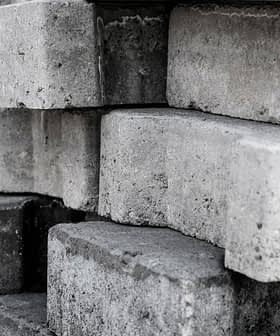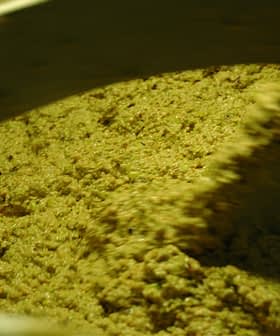Bricks Made with Olive Pits Reduce Carbon Footprint of Buildings, Study Finds

Spanish researchers from the University of La Rioja use ground olive pits in mortar bricks to create more energy-efficient building materials, leading to economic savings and reduced environmental impact. The study analyzed the impacts of adding ground olive pits to mortar bricks for building construction, demonstrating potential long-term savings and environmental benefits by reducing conventional energy consumption.
Spanish researchers from the University of La Rioja’s mechanical engineering department use ground olive pits to produce more energy-efficient building materials.
The researchers demonstrated that using ground olive pits in mortar brick manufacturing can lead to significant economic savings and reduce the environmental impact of construction and building use.
The research analyzed the impacts of doping perforated mortar bricks with ground olive pits in a five to 15 percent ratio by volume of fine aggregate for building construction.
The use of olive pit waste in the manufacture of facade bricks is a clear example of how the circular economy can transform an industry’s by-products into innovative and sustainable building materials.
Doping is a technique in which a small quantity of a substance is added to a material to alter its properties. The method is employed in the manufacture of construction materials to increase their energy efficiency, strength, durability, fire resistance or corrosion resistance.
In recent years, more research has focused on doping to reduce thermal conductivity, which could lower the energy required to heat or cool buildings.
Buildings are Europe’s single largest energy consumer. Approximately 40 percent of the total energy consumed in the European Union is used in buildings, and around 80 percent of the energy used in E.U. homes is for heating, cooling and hot water.
See Also:Researchers Transform Olive Grove Waste Into BioplasticEighty-five percent of E.U. buildings were built before 2000, and 75 percent have poor energy performance. The construction sector is, therefore, seen as crucial to achieving the E.U.‘s energy and climate goals.
The study focused mainly on Andalusia, Spain, where large quantities of olive pits are produced as a by-product of olive oil production.
“My initial interest arose from observing the enormous volume of waste generated by the olive oil industry, specifically olive pits,” said lead author Javier Ferreiro-Cabello.
“These residues have significant but underutilized potential in terms of reuse and added value,” he added. “In studying possible applications for these pits, I identified the possibility of using them to manufacture bricks for mortar facades. This idea led me to further investigate the feasibility and environmental impact of this proposal.”
The team’s analysis showed savings and economic returns from the medium-term (10 to 20 years) onward by reducing conventional energy consumption in heating and air conditioning installations.
Previous research by Ferreiro et al. has demonstrated that doping with ground olive pit concentrations of up to 30 percent can be used without compromising structural viability. Concentrations above 15 percent were found to increase the economic recovery time beyond the average useful life of a building in Spain (70 years).
Several factors were studied to assess environmental impact. These spanned the full lifecycle of the product, from olive pit grinding and its subsequent transportation to the production and transportation of doped mortar bricks.
When analyzing the end product’s net impact over time, the resources used — energy, fuel and water — and the waste products generated — carbon oxides, nitrogen oxides and solid particles — were considered.
Increasing the percentage of olive pits as a substitute for fine aggregate was found to raise environmental impacts in most categories, except for water usage.
Higher olive pit content lowers the water impact because natural aggregate production requires substantial water for internal washing processes.
A 15 percent doping with olive pits resulted in a 7.98 percent reduction in water consumption, saving 0.61 cubic meters per square meter of the facade.
In the global warming category, a 4.68 percent increase in CO2 emissions was calculated for 15 percent doping, equating to 0.8 kilograms of CO2 per square meter of facade. This increase was due to the higher energy and resource consumption needed to incorporate olive pits.
Categories related to natural aggregate production, including acidification, eutrophication, and photochemical oxidation, saw increases of 29.13 percent, 30.28 percent, and 21.56 percent, respectively. The olive pit preparation process, involving energy and material use for crushing and transport, caused these impacts.
See Also:Olive Milling Byproducts May Improve Animal FeedTransport processes were found to significantly affect recycled aggregates’ viability, increasing nitrogen oxides, carbon oxides and solid particles that impact the ozone layer.
A 15 percent doping showed an 8.90 percent increase in ozone layer depletion and an 8.19 percent rise in fossil fuel depletion, equivalent to 6.90 megajoules per square meter of facade.
When calculated over a 35-year period, however, the increases in energy use and emissions associated with the initial manufacturing process were more than offset by the overall savings.
The analysis showed that over this period, the net energy cost of 15 percent-doped material manufacture was below zero, and the CO2 emissions were also below zero for all building energy sources. This latter was most remarkable for buildings using electrical power sources, with a reduction of 105.84 percent.
However, the authors stress that the benefits of olive-pit doping are limited to regions where olive waste is abundant and local, as transport is a significant contributor to energy usage and emissions. Thus, increased transport would result in significantly fewer benefits.
They also note that this is only one of many examples of the industry’s potential for increased sustainability.
“The circular economy will play a key role in the future of construction by offering sustainable and efficient solutions to address environmental and economic challenges,” Ferreiro said. “By adopting principles of reuse, recycling and waste reduction, the construction industry can minimize its environmental impact and maximize resource use.”
“In the specific context of my research, the use of olive pit waste in the manufacture of facade bricks is a clear example of how the circular economy can transform an industry’s by-products into innovative and sustainable building materials,” he added.
Many initiatives to increase sustainability in the buildings and construction sectors are in place worldwide.
These range from multinational programs such as the United Nations’ Sustainable Development Goal 12 and the European Union’s Strategy for Sustainability in Construction and Renovation Wave programs to legislation at national and local levels.
However, Ferreiro believes that much more can be done.
“The government can play a crucial role in encouraging research and development in the field of sustainable construction through supportive policies and programs,” he said. “This could include financial incentives for companies investing in research and development projects related to the circular economy and sustainability in construction.”
“In addition, the government could establish regulations and standards that promote the use of recycled materials and the adoption of sustainable practices in the construction industry,” Ferreiro concluded. “Education and awareness programs could also help sensitize key stakeholders to the importance of sustainability and the circular economy in construction.”









